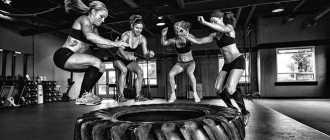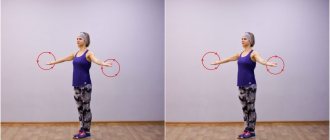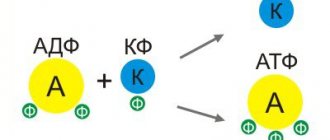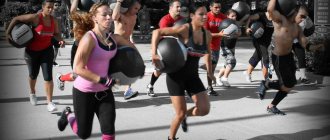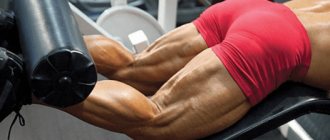The development of physical qualities (strength) has general patterns regardless of the role of the activity. Therefore, while there are two sides to the process of physical training - improvement of motor skills and development of motor qualities, this work examines only its second side. The criteria for assessing human motor function are four main motor qualities: strength, speed, endurance and flexibility. Each of these qualities has its own structure and characteristics.
For the practical application of strength development methods, it is necessary to have at least a general understanding of the basics of its development, improvement and consolidation in muscle memory.
Strength as a physical quality of a person
Any human movements are the result of coordinated activity of the central nervous system and peripheral parts of the motor system.
The active elements of the human locomotor system are skeletal muscles
. They are formed by striated muscle fibers. Each muscle fiber is surrounded by a transparent membrane containing elastic collagen filaments. Small groups of muscle fibers are enclosed in a sheath of connective tissue, while larger bundles of muscle fibers and the muscle as a whole are surrounded by loose connective tissue. All connecting muscle structures are continuously interconnected and are a continuation of each other. They form a parallel elastic element of the muscle.
In modern mechanics, it is customary to call any action of one material body on another, resulting in a change in the state of rest or motion of the body.
Thanks to muscle power, the human body moves in space. From changes in magnitude and direction
The application of force changes the speed and nature of movement. Defining human muscle strength as a physical quality, we can talk about the ability to overcome external resistance or counteract it due to muscle tension. External resistance can be the force of gravity, equal to the weight of the athlete; reaction of the support when pressure is applied to it; resistance of the external environment when the athlete moves; weight of burdens; resistance of a partner, elastic spring or rubber; inertial force of other bodies.
By force is meant
a person’s ability to overcome external resistance or counteract it through muscle effort. An essential factor that determines muscle strength is the mode of muscle activity. In the process of performing sports or professional techniques and actions, a person can lift, lower or hold heavy loads.
If, overcoming resistance, the muscles contract and shorten, then their work is called overcoming (concentric).
Muscles that resist resistance can lengthen (for example, when holding a heavy load). In this case, their work is called inferior (eccentric).
The overcoming and yielding mode of muscle work is called dynamic.
Muscle contraction under constant tension or load is called isotonic
. With isotonic contraction of a muscle, not only the magnitude of its shortening is important, but also the speed of its shortening (the lower the load, the greater the speed). This mode of operation is found in strength exercises with a barbell, dumbbells, kettlebells, etc. The amount of force in the isotonic mode is measured along the trajectory of movements, because the levers for applying force change in different phases of movements. Exercises with a barbell or other apparatus at high speed do not give the desired effect, because... muscular efforts at the beginning of work impart acceleration to the projectile and further work along the movement is performed by inertia. Barbell exercises are used mainly to develop maximum strength and build muscle mass, and are performed evenly at a slow to medium pace.
The mode of muscle work, in which it is not the magnitude of the weight that is set, but the speed of movement of the body parts, is called isokinetic
.
Performing strength exercises with a high speed of movement is used to develop strength
without a significant increase in muscle mass, the need to reduce fat, and to develop
speed-strength
qualities. For this purpose, isokinetic simulators are used, where the muscles have the ability to work with optimal load along the entire trajectory of movement. Isokinetic simulators are used by swimmers, as well as in general physical training.
When performing movements, a person often uses force without changing the length of the muscles. This mode of operation is called isometric or static
, at which the muscles exhibit their maximum strength.
For the body, the isometric
mode turns out to be the most unfavorable, because the excitation of the nerve centers, which are under high load, is quickly replaced by an inhibitory protective process, and tense muscles, squeezing the blood vessels, prevent normal blood supply, and performance quickly decreases.
Everything you need to know
Endurance depends on three parameters:
- The ratio of muscle fibers in the athlete's body. Those athletes who have more “slow” fibers are naturally more resilient;
- VO2 max or oxygen uptake rate is a parameter that measures how quickly redox reactions occur in the body. This parameter is determined genetically, but is trainable. High-intensity interval training, such as alternating sprints and long recovery periods, or even circuit training, can increase this parameter;
- Lactate or anaerobic threshold is a parameter that determines at what level of load the athlete’s body begins to accumulate lactate, and the muscles “clog” and prevent them from performing high-repetition work with the same intensity. Work can be performed at high intensity for a long time, and then the lactate threshold increases
All endurance parameters are determined genetically, but they are trainable. To increase endurance, training is used that is very close to what is practiced in fitness for weight loss. This is a combination of circuit training, running or other aerobic work at moderate to high intensity, and recovery activities.
Is it possible to improve muscle readiness for endurance work? Frankly, the ratio of fibers cannot be changed, but an athlete can develop “slow” fibers through regular training.
Structure of human strength abilities
When characterizing the strength qualities of a person, the following varieties are distinguished:
- Maximum isometric (static) strength
is an indicator of the strength exerted when holding overhead weights or resistance with maximum muscle tension for a certain time. - Slow dynamic (pressing) force
, manifested during the movement of objects of large mass, when speed practically does not matter, and the applied forces reach maximum values. - High-speed dynamic strength
is characterized by a person’s ability to move large (submaximal) weights with an acceleration below maximum in a limited time. - “Explosive strength”
is the ability to overcome resistance with maximum muscle tension in the shortest possible time. With the “explosive” nature of muscle efforts, the developed accelerations reach the maximum possible values. - Cushioning force
is characterized by the development of force in a short time in a inferior mode of muscle work, for example, when landing on a support in various types of jumps or when overcoming obstacles, in hand-to-hand combat, etc. - Strength endurance
is determined by the ability to maintain the necessary strength characteristics of movements for a long time. Among the types of endurance for power work, endurance for dynamic work is static endurance. Endurance for dynamic work is determined by the ability to maintain performance when performing professional activities associated with lifting and moving heavy objects, with long-term overcoming of external resistance. Static endurance is the ability to maintain static efforts and maintain sedentary position of the body or being in a room with limited space for a long time.
Recently, another strength characteristic has been identified - the ability to switch from one mode of muscle work to another, if necessary, the maximum or submaximal level of manifestation of each strength quality. To develop this ability, which depends on a person’s coordination abilities, a special focus of training is needed.
Rapidity
Speed is the ability of a person to perform motor actions in the minimum amount of time for given conditions, without reducing the effectiveness of the technique performed.
divided into 2 groups:
a) speed of a single movement (for example running)
b) the speed of motor reactions is a process that begins with the perception of information stimulating actions and ends with the beginning of response reactions.
Every person has a phenomenon when he cannot “beat” his result.
The speed barrier is the habit of covering distances at a certain speed.
We won't talk about him. I think you yourself understand that you need to get rid of this habit!!! =)
Sensitive periods for the development of speed: 10 - 11 years and 14 - 15
Strength Development Tools
The means of developing muscle strength are various strength exercises, among which three main types can be distinguished:
- Exercises with external resistance.
- Exercises to overcome your own body weight.
- Isometric exercises.
Exercises with external resistance
are one of the most effective means of developing strength and are divided into:
- Exercises with weights. With their help, you can influence not only individual muscles, but also individual parts of muscles.
- Exercises with a partner. These exercises have a beneficial emotional effect on those involved.
- Exercises with resistance from elastic objects (rubber shock absorbers, harnesses, etc.). Their advantage lies in their low dead weight, small volume, and ease of use.
- Exercises to overcome the resistance of the external environment (running uphill, on sand, water, etc.).
Exercises to overcome your own weight
widely used in all forms of physical training. They are divided into:
- Gymnastic strength exercises: pull-ups with different grips on the bar, push-ups on hands while lying down, etc.
- Athletics jumping exercises: single and “short” jumping exercises, including up to five repeated take-offs, “long” jumping exercises with multiple take-offs over segments of 30-50 meters, “deep” jumps from an elevation followed by take-off.
Gymnastic strength exercises
are an excellent tool for developing the muscles of the arms, shoulder girdle, abdominals and back.
Isometric exercises help to simultaneously tense the maximum possible number of motor units of working muscles. There are exercises in passive tension (holding a load, etc.) and exercises in active muscle tension (for 5-10 seconds in a certain position).
Static exercises should be used with great caution, combining them with dynamic exercises, and also following the principle of systematic and consistent load building. It is necessary to take into account the power of the impact of these exercises on the nervous and cardiovascular systems. Strong muscle tension compresses the blood vessels and, as a result, causes local disruption of blood flow.
Common mistakes
I’ll briefly talk about the global mistakes that athletes make when developing speed endurance skills:
- Training without constant recording of results and testing.
- Attempts to train independently and without a trainer (suitable only for amateurs and the development of general, not speed, type of endurance).
- Using one technique or exercise.
- Simultaneous development in all power zones.
- Sacrificing technology for the sake of improving performance.
Methods for developing strength abilities
By their nature, all exercises are divided into three main groups: general, regional and local effects on muscle groups. General impact exercises include those in which at least 2/3 of the total muscle volume is involved in the work, regional – from 1/3 to 2/3, local – less than 1/3 of all muscles.
Direction of impact
strength exercises are mainly determined by their following components (see table):
- type and nature of the exercise;
- the amount of burden or resistance;
- number of repetitions of exercises;
- the speed of performing overcoming or yielding movements;
- the pace of the exercise;
- the nature and duration of rest intervals between approaches.
Maximum Effort Method
The maximal effort method includes exercises with submaximal, maximal, and supramaximal weights and resistance. It ensures the development of muscle capacity for strong contractions and maximum strength without a significant increase in muscle mass. There are several methods for practical implementation of the method:
Uniform - the exercise is performed with a weight of 90-95% of the maximum: repeat 2-3 times in 2-4 trips at intervals of 2-5 minutes.
“Pyramid” - several approaches are performed with increasing weight and reducing the number of repetitions in each subsequent approach, for example:
- lift 85% weight 5 times;
- lift 90% weight 3 times;
- lift 95% weight 2 times;
- lift weight 97-100% 1 time;
- with a weight of more than 100% - try to perform 1 time. Rest intervals between sets are 2-4 minutes.
Maximum - the exercise is performed with the maximum possible weight at a given time: 1 time x 4-5 approaches with arbitrary rest.
| Strength Development Methods | Focus of strength development methods | Contents of load components | |||||
| Weight weight,% of max. | Number of repetitions of the exercise | Number of approaches | Rest, min. | Speed of overcoming movements | Pace of exercise | ||
| Maximum Effort Method | Preferential development of maximum strength | Up to 100 or more | 1-3 | 2-5 | 2-5 | Slow | Arbitrary |
| Development of maximum strength with a slight increase in muscle mass | 90-95 | 5-6 | 2-5 | 2-5 | Slow | Arbitrary | |
| Repeated Effort Method | Simultaneously increase strength and muscle mass | 85-90 | 5-6 | 3-6 | 2-3 | Average | Average |
| Predominant increase in muscle mass with a simultaneous increase in maximum strength | 80-85 | 8-10 | 3-6 | 2-3 | Average | Average | |
| Reducing the fat component of body weight while increasing maximum strength | 50-70 | 15-30 | 3-6 | 3-6 | Average | High to max | |
| Improving strength endurance and muscle definition | 30-60 | 50-100 | 2-6 | 5-6 | High | High | |
| Ultimate effort method (“to failure”) | Improving strength endurance (anaerobic performance) | 30-70 | Until “refusal” | 2-4 | 5-10 | High | Submaximal |
| Improving strength endurance (glycolytic capacity) | 20-60 | Until “refusal” | 2-4 | 1-3 | High | Submaximal | |
| Dynamic force method | Improving the speed of weighted movements | 15-35 | 1-3 | Before the speed drops | Before recovery | Maximum | High |
| “Shock” method of developing strength | Improving the “explosive” strength and reactive ability of the motor system | 15-35 | 5-8 | Before the power drops | Before recovery | Maximum | Arbitrary |
Repeated Effort Method
As the main training factor
This method is based on the number of repetitions of the exercise with optimal or submaximal weight. This method uses various options for constructing a workout. Depending on the selected components of the exercise, the focus of the method may vary (see table)
| Conditional intensity levels | Weight of burden in % of max | Number of possible repetitions in one approach (repetition maximum - RM) |
| 1 | v.100 | 1 |
| 2 | 100 | 1 |
| 3 | 90 | 2-3 |
| 4 | 90 | 3-5 |
| 5 | 85 | 5-7 |
| 6 | 80 | 8-10 |
| 7 | 75 | 10-12 |
| 8 | 70 | 12-15 |
| 9 | 65 | 15-18 |
| 10 | 60 | 18-20 |
| 11 | 50 | 20-30 |
| 12 | 40 | St.30 |
For its practical implementation, various methodological techniques are used: uniform, super series and combinations of exercises, circular.
Separately, methods for developing “explosive” and reactive strength, dynamic strength, and working to failure are highlighted.
Inside the “to failure” method
Various techniques can be used:
- Perform exercises to failure in each approach, but limit the number of approaches;
- in each approach, perform a fixed number of repetitions, and the number of approaches until failure;
- perform the number of approaches and repetitions to failure.
Impact method
Used to develop shock absorption and explosive force
various muscle groups. When training the leg muscles, push-offs are used after a deep jump from a measured height.
The optimal dosage of jumping shock exercises should not exceed four series of 10 jumps each for well-trained people, for less prepared people - 1-3 series of 6-8 jumps.
It is possible to use the shock method to train other muscle groups with weights or your own body weight.
When performing exercises with weights using the impact method, it is recommended
comply with the following rules:
- They can be used only after warming up the muscle groups being trained.
- The dosage of exercises should not exceed 5-8 repetitions in one series.
- The magnitude of the impact is determined by the weight of the load and the magnitude of the working range of motion.
- The starting position is selected taking into account its correspondence to the position at which the working force develops in the exercise being trained.
Methods for developing explosive strength and muscle reactivity
To develop “explosive” muscle strength
(plyometrics) and the reactive ability of the neuromuscular system is used both as the entire arsenal of strength training means, and in combination:
- weight training
- jumping exercises
- exercises with shock mode of muscle work
- isometric exercises
Resistance exercises primarily use a method of repeated effort. At the same time, it is also possible to use the method of maximum effort when, in the context of professional applied or sports activities, one has to overcome significant external resistance.
Jumping exercises (plyometric exercises) are successfully used to develop the “explosive” strength of the leg muscles (jumping ability) and are performed with single or multiple push-offs with maximum effort.
Most often, complex programs are used in training using a wide range of means and methods for improving “explosive” strength.
.
Method for developing dynamic (speed) strength
Speed Force
occurs during rapid movements against relatively little external resistance. To develop speed strength, exercises with weights, jumps from heights, jumping exercises and complexes of the listed training means are used.
Weights are used both for local development of muscle groups and for improving the holistic structure of sports exercises or professional activities. In this case, two ranges of weights are used:
- with a weight of 30% of the maximum
- with a weight of 30-70% of the maximum
Exercises with weights are used repeatedly in various variations to develop dynamic strength.
Jumping exercises in any variations should be performed with a focus on the speed of repulsion, and not on its power.
The greatest increase in the development of speed strength is provided by exercises on machines with an isokinetic mode of muscle work.
Methods for developing strength endurance
Strength endurance
– the ability to demonstrate optimal muscle effort for a long time is one of the most significant motor qualities in professional-applied physical training and sports.
Strength endurance is a complex, complex physical quality.
The process of developing strength endurance
is closely related to the development of the vegetative functions of the body. Since the development of autonomic functions occurs much more slowly than motor ones, the immediate process of developing strength endurance must be preceded by a large amount of work aimed primarily at the development of autonomic functions.
The development of strength endurance should be carried out comprehensively, based on the parallel improvement of autonomic systems and strength abilities.
The following methods are typical for the development of strength endurance: repeated, interval, variable, “to failure”, circular, etc.
The main method of developing strength endurance
is a method of repeated efforts with the implementation of various methodological techniques. However, the difficulty of developing this motor quality also lies in the possible negative interaction of the effects of training exercises.
Increasing the effectiveness of training loads is associated with an analytical approach to their application, i.e. using exercises and complexes in one lesson that have a selective, targeted effect on leading factors.
Isometric method
Isometric method
characterized by short-term muscle tension without changing their length. The exercises performed by this method are recommended to be used as additional means of developing strength.
Muscle tension should be increased smoothly to the maximum or specified value, and held for several seconds. Depending on the force developed (see table)
| Developed force, % | 40-50 | 60-70 | 80-90 | 100 |
| Voltage time, sec. | 10-15 | 6-10 | 4-6 | 2-3 |
It is advisable to perform isometric tension in positions and postures that are adequate to the moment of manifestation of maximum effort in the exercise being trained. A combination of isometric tension with stretching and relaxation exercises is effective.
Assessing your speed endurance
There are many methods for testing speed endurance. They are divided depending on the type of energy supply. Most often this is the task of a coach in a particular sport. As an example, I will give a simple and popular method - the Henman test. To perform it, you need a stopwatch and two lines drawn parallel to each other at a distance of 20 meters.
The athlete’s task is to perform a shuttle run from line to line in 60 seconds at maximum speed. After the active phase, the subject is given a one-minute rest, followed by another 60-second session. There will be 5 such segments in total, with a minute's rest between each. The coach’s task is to record the number of runs from line to line over the course of a minute, as well as where the athlete stops at the end of the 60-second period. Based on the data obtained, the athlete’s capabilities are determined.
Features of organizing strength training for teenagers, girls, women and the elderly
Properly organized exercises to develop strength have a beneficial effect on the health and physical development of not only adult men, but also adolescents, girls, women and the elderly. Myths about the dangers of strength exercises are completely unfounded for them - harm can only be caused by excessive, incorrectly planned loads. Experimental studies have established that even six-year-old children, engaged in weightlifting exercises, progress in their development, sports skills and do not have deviations in their health status with a rationally structured training process. At the same time, it is necessary to take into account the age and gender characteristics of the body of people involved in strength exercises to improve health and vocational training.
Even if teenagers and girls look like adults, fully developed people, this does not mean that they are able to perform the same strength loads as adults.
In the period of 12-16 years, intensive development
the body of teenagers and girls.
This is manifested in rapid body growth and strengthening of the musculoskeletal system, muscle mass building, changes in the endocrine and nervous systems, and puberty. During this period, the capabilities of the cardiovascular system do not always “keep up” with the intensive development of other body systems
, and excessive loads can lead to premature cessation of growth and development.
The main stimulator of muscle growth and strength is testosterone, the male sex hormone. In adolescence, during puberty, the secretion of hormones increases significantly. Therefore, already at the age of 11-13 years for girls and at 13-15 years for adolescents, favorable conditions appear for the development of strength
. This period lasts until about 30 years or more. Restrictions apply to large weights, which can lead to the formation of inguinal hernias and disorders in the development of the spine. Exercises with strong straining are also contraindicated. It is advisable to develop strength either without weights or with weights of 50-60% of the maximum strength of adolescents and girls under the supervision of a doctor. The goal of strength training in this age period is the formation of a powerful muscle corset that protects and supports the torso and internal organs, creating a base for further strength loads. Strength exercises should never be aimed at developing maximum or speed strength. In-depth training in strength exercises should be preceded by general physical training.
In recent years, an increasing number of women have been purposefully engaged in strength exercises, not only to improve professional performance, but also to improve their physical development and figure correction. Absolute physical indicators in women are much lower than in men.
Features of women's strength training
are associated with the physiological characteristics of their body, objective differences between men and women:
- women are on average smaller and lighter than men;
- the hormonal structure of the female body limits the growth of muscle mass;
- the proportion of muscles in the total body weight in women is much smaller and is only 30-35% compared to 40-47% in men;
- The center of mass of the body in women is lower than in men due to the characteristics of the physique - women have a longer torso and shorter legs;
- women, due to the faster maturation of their bodies, reach their physical, including strength, standards 2-4 years faster than men;
- for women, an increase in fat deposits on the hips and buttocks is typical, for men – on the abdomen;
- women, on average, have greater flexibility compared to men;
- women have a higher pain threshold (i.e. they are more patient) than men.
Scientific research and practical experience show. That strength training, taking into account the physiological characteristics of the body, helps improve health, strengthens the muscles and ligaments of the pelvic floor, and improves the figure.
The musculoskeletal system of women tolerates large force loads much worse. When training, they should avoid working with extreme or close to extreme weights. Preference should be given to exercises that do not “overload” the spine, i.e. performed in a sitting or lying position. The female body tolerates loads aimed at developing endurance
. Therefore, methods for developing strength endurance are widely used in training: they involve light weights, quickly reduce the fat component of body weight, and help solve problems of aesthetic correction of the physique.
To effectively solve such problems, women, like men, need to pay increased attention to the development of aerobic endurance, flexibility and coordination of movements. Currently, strength exercises in the form of rhythmic gymnastics and shaping are widespread among women.
Elderly people are not recommended to get carried away with heavy weights and high volumes of load. Physical education classes at this age should be comprehensive, i.e. include, in addition to strength exercises, also exercises for aerobic endurance, flexibility and coordination, with priority for exercises for general and strength endurance. Strength exercises, like women, are best performed in a sitting or lying position, so as not to overload the spine.
Basic rules for organizing strength training for teenagers, girls, women and the elderly.
- When doing strength exercises, strictly follow the general methodological principles of constructing the training process.
- General physical training is the basis for success in developing strength. Therefore. include in your training exercises to develop endurance, speed, flexibility, coordination and accuracy of movements. Sports and outdoor games.
- Training should not be monotonous.
- Before the age of 16, do not perform strength exercises with maximum weights. Use lighter weights with the ability to perform each training exercise 10-15 times.
- Pay attention to strengthening your abdominal and back muscles.
- Prevent injuries - they are the result of improper training.
- Do not perform deep squats with heavy weights, deep jumps, barbell deadlifts, or standing heavy barbell presses. When performing exercises with a barbell, make sure your back is straight.
- Do not get carried away with exercises with an eccentric mode of operation.
- Stop training if pain occurs.
- Get checked regularly by your doctor.
General rules for preventing injuries when performing strength exercises
- Before each workout, first do a general warm-up. Do a special warm-up before exercises with extreme weights and after rest.
- Maintain order and safety measures in the hall.
- Before each workout, it is necessary to carefully check the serviceability of simulators, devices and equipment.
- Never be distracted when doing strength exercises.
- Use correct movement technique. Avoid straining. When performing exercises with a heavy barbell, pay attention to the position of your back: it should be straight to avoid injury to the spine.
- When working with extreme and large weights, do not forget about insurance. Increase power loads gradually.
- Eliminate exercises from your workout that cause pain. Be sure to find out from a specialist the reasons for their occurrence. Pain is a signal warning of the possibility of serious injury.
During intense training, various pain sensations may occur in muscles and ligaments : during the actual exercise, after training and after a certain period of time.
- If pain occurs during an exercise, the most likely causes may be insufficient warm-up or inadequate weight, leading to microtrauma to muscles and ligaments. In this case, you need to stop training, carefully do an additional warm-up and change the training program.
- Pain may occur after the workout ends. These are so-called physiological pains, indicating changes occurring in the muscles. They may be associated with the accumulation of large amounts of lactic acid, with a change in intramuscular osmotic pressure, which contributes to the retention of intercellular fluid rich in nutrients in the muscles. After rest and performing simple rehabilitation measures, such pain disappears.
- In poorly trained people, pain may occur 12-14 hours after the end of training. They are not dangerous to health, but indicate that the body is unprepared for the applied loads. Therefore, after long breaks in training, do not force the volume and intensity of work, but increase them gradually.
Sources:
- Kuznetsov V.V. Strength training of elite athletes. M.: F and S. 1970
- Vaitsekhovsky S.M. Trainer's book. M.: F and S. 1971
- Matveev L.P. Theory and methodology of physical education. M.: F and S. 1976
- Volkov V.M. Restorative processes in sports. M.:F and S. 1977
- Dembo A.G. Diseases and injuries during sports. Leningrad: Medicine. 1991
- Filin V.P., Fomin N.A. Fundamentals of youth sports. M.: F and S. 1980
- Aulik I.V. Determination of physical performance in the clinic and sports. M.: Medicine. 1979
- www.academ.lunn.ru
⚠ [All materials are for informational purposes only. Disclaimer krok8.com ]
Training Tips
You can train endurance every day, but in order for these exercises to have an effect, you must comply with the main condition - a healthy lifestyle. That is, if you smoke or drink alcohol, then you don’t have to think about your performance. To begin with, in any case, you will have to “take off the mask” of bad habits, and also switch to a proper daily routine and a healthy diet.
Breathing and tempo are important during execution. They are determined individually, so you choose the weight of the projectiles and the frequency of repetitions yourself. Just remember that their number should be maximum, but not less than 20, otherwise you will develop muscles. Accordingly, this also applies to running - it should be easy and last at least 30 minutes.
Equipment
Clothing is a purely personal matter. Endurance training is no different from other training, so the equipment doesn’t differ much either.
In such cases, I always advise using a simple tracksuit that is highly breathable and made of very light material. It’s great if it also stretches. A polyamide or elastane synthetic suit is suitable, the material of which has high strength and poor absorbency.
Sets and reps
Endurance develops not due to the large weight of the equipment used, but through repeated repetitions. In professional language, this is called crossfit or circuit training, when elements are done one after another with short pauses between approaches. By the way, there should be at least two of them.
The duration of the exercise is also important - the longer you do the exercise, the better the effect will be. Therefore, all elements in training must be performed to such an extent until the muscles begin to become numb or numb. This will mean that lactate began to be produced in their fibers, and their heart rate (heart rate) increased to the required value, which is what is needed for the development of endurance.
Everything you need to know
Endurance allows people to exercise at a certain intensity and for an extended period of time (think of a marathon). There are many factors that combine to determine an athlete's endurance level, but two that are of key importance are VO2 max and anaerobic threshold.
VO2 max is the maximum rate at which an athlete's body can absorb oxygen during exercise. Measuring this parameter is the most popular method for determining the level of physical fitness, however, it is not the most accurate. Although endurance is largely genetic, oxygen uptake can be improved through specific training such as high-intensity interval training.
Another important parameter that determines an athlete's endurance level is the anaerobic threshold, or the level of physical activity at which lactate begins to accumulate in the muscles. Fortunately, almost any athlete can improve both of these parameters. In order to increase your anaerobic threshold, and therefore your ability to train harder for a longer time, you need to run at a moderate pace, according to renowned sports expert Noam Tamir.
Endurance athletes have a higher proportion of slow-twitch muscle fibers, which use oxygen evenly to generate energy. Long-distance running develops slow-twitch muscle fibers, which continuously provide energy and allow you to more effectively fight fatigue. Also, long running allows you to convert fast muscle fibers into slow ones, which also improves endurance.

